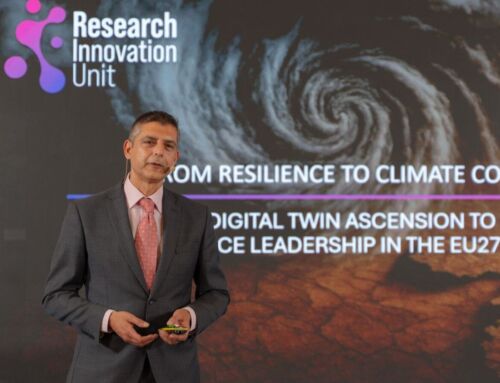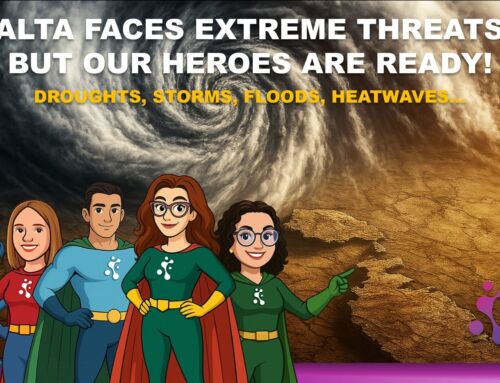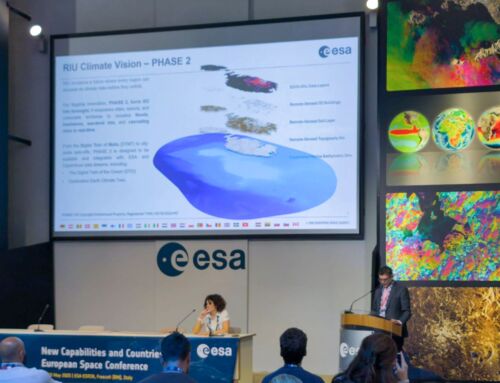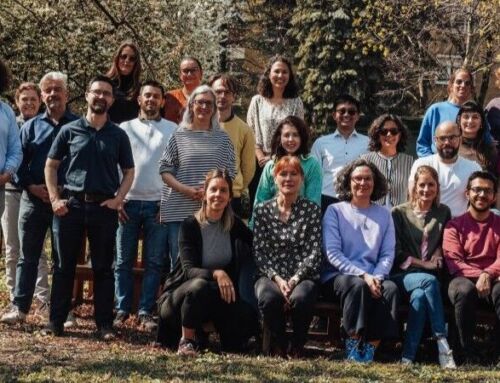As 2024 comes to a close, it is a moment of reflection on my extensive work and climate leadership throughout this year and that of my unit, aiming to provide added value for 2025. This year, not only we launched one of the most ambitious projects in Malta’s climate adaptation and resilience landscape, i.e. the Digital Twin of Malta (DTMT-01) in Beta Version 1, but also significantly advanced our efforts in climate resilience through collaborations, cutting-edge solutions, and impactful initiatives. This editorial summarises the progress made throughout 2024. It highlights how the Research Innovation Unit (RIU) has become a beacon of climate innovation and leadership on the global stage.
The Launch of DTMT-01: A Turning Point for Climate Resilience
On December 24, 2024, the Digital Twin of Malta (DTMT-01) was publicly introduced on LinkedIn. This project, a unique and groundbreaking initiative, represents a culmination of years of research, innovation, and strategic collaboration. As the first digital twin of its kind for Malta, DTMT-01 integrates bathymetry, topography, and a 3D building layer that classifies structures by function, ranging from private and public buildings to heritage and industrial assets.
One of the standout features of DTMT-01 is its hybrid bathymetry and topography resolution. DTMT-01’s Digital Terrain Model (DTM) offers a 30-meter resolution for the country and a super-resolution DTM raging 50 meters inland along Malta’s coastline. This meticulous attention to detail ensures that critical heritage sites, including UNESCO World Heritage locations, are accurately embodied, setting a new standard in digital twin technology for climate resilience.
DTMT-01’s capabilities extend beyond digital mapping and visualisation in a geospatial space. It acts as a climate impact simulator, enabling stakeholders to model scenarios such as sea-level rise, storm surges, tsunami impacts, urban flooding, heat stress and agricultural droughts. The platform operates seamlessly on QGIS, ESRI ArcGIS and Anaconda, making it accessible and powerful for planners and policymakers. The successful deployment of DTMT-01 firmly places Malta, and by extension, my leadership, among the global pioneers in leveraging digital twin technology for climate resilience.
Key Features of DTMT-01:
- Precision Modelling: Hybrid-resolution datasets ensure detailed analyses, with coastal areas benefiting from super-erosion data to account for critical heritage and coastal erosion.
- 3D Building Classification: The platform categorises structures by function, enabling tailored urban planning and risk assessments.
- Scenario Simulations: DTMT-01 can model diverse climate impacts, from urban flooding to storm surges, allowing stakeholders to prepare and respond effectively.
- Interoperability: Seamless integration with QGIS, ESRI ArcGIS and Anaconda ensures accessibility for various users.
Expanding the Use Cases:
DTMT-01 is a visualisation tool and a comprehensive decision-support system. Throughout 2024, we showcased its applications in workshops and international events, emphasising its potential to simulate:
- Sea-Level Rise: Predictive modelling of how rising seas could affect Malta’s densely populated coastal regions.
- Storm Surges and Tsunamis: Assessing the vulnerability of key urban and heritage areas to extreme maritime events.
- Urban Heat Islands (UHI): DTMT -01 will be used to identify hotspots and propose cooling strategies, such as urban greening, ethical geoengineering, and reflective surfaces.
- Drought Impacts: Modelling agricultural vulnerabilities and water management scenarios under prolonged dry spells.
Positioning Malta Among Global Leaders
The successful launch of DTMT-01 invites a comparison with similar initiatives worldwide. While countries like Singapore, Finland, and the Netherlands have embraced digital twin technology, DTMT-01 stands out for its holistic integration of coastal heritage preservation, urban classification, and climate impact simulation. This achievement is a testament to RIU’s hard work and vision and my dedication to advancing climate adaptation solutions.
Advancing Climate Resilience Through Strategic Collaborations
2024 has been a year of impactful collaborations, both locally and internationally. Below are the key events and milestones that shaped this year:
- European Roundtable on Climate Risk Management (Brussels): This high-level meeting brought together policymakers, academics, and industry leaders to address escalating climate risks. My contributions focused on integrating hybrid solutions by combining Nature-Based Solutions (NBS) with ethical geoengineering, a concept that involves using engineering techniques to mitigate climate change impacts ethically and sustainably to address extreme heat and humidity challenges. I advocated for immediate action, emphasising the urgency of adapting to an evolving climate reality.
- EEA Eionet Expert Workshop (Copenhagen): The European Environment Agency hosted this workshop to refine climate adaptation knowledge platforms. I proposed integrating Artificial Intelligence (AI) tools to personalise user experiences and improve data accessibility. These tools can analyse user preferences and behaviour to provide tailored information and recommendations, aligning with RIU’s commitment to user-centred solutions. These well-received ideas laid the groundwork for the upcoming Climate-ADAPT Strategy for 2025-2027.
- JUSTNature Project Progress Meeting (Gżira): Hosting the 6th Progress Meeting of the JUSTNature project was a proud moment for RIU. Representatives from six cities convened to discuss urban transformations, focusing on fairness and inclusivity in sustainability initiatives. The meeting showcased RIU’s leadership in embedding nature-based solutions into urban planning while addressing challenges like extreme urban heat.
- Local Councils’ Expo 2024 (Malta): This event highlighted the vital role of local governance in driving climate resilience. RIU presented innovative solutions, including the Digital Twin project, and facilitated workshops on El Niño–Southern Oscillation (ENSO) impacts and hybrid adaptation strategies.
Driving Public Discourse Through Climate Editorials
2024 also marked the launch of a dedicated section for climate editorials on RIU’s website. These editorials aim to inform, inspire, and challenge readers to think critically about climate issues. Below are some of the standout pieces published in 2024:
- Integrating Justice in Sustainability Transitions: This editorial explores the urgency of embedding fairness and inclusivity into urban planning, drawing from RIU’s work in the JUSTNature project. It highlights the transformative potential of ensuring all communities benefit from sustainability initiatives.
- Barcelona Flash Floods: A reflection on the catastrophic floods in Barcelona, this piece underscores the Mediterranean basin’s vulnerability to extreme weather. It calls for adaptive urban planning and resilient infrastructure to mitigate future risks.
- Desertification Dynamics: This analysis compares the Sahara’s expansion with environmental degradation in Malta, emphasising the need for proactive measures to combat desertification and protect agricultural lands.
- EU Climate Ambitions at a Crossroads: This critique examines the European Union’s leadership in global climate politics, urging sustained commitment amidst fragmented international efforts.
Innovation Beyond Borders: Acknowledging Global Context
RIU’s work in 2024 has been about making a local impact and contributing to the global climate discourse. By participating in high-level EU events and workshops, we have shared Malta’s unique challenges and innovative solutions with a broader audience, advocating for a unified approach to climate resilience. Our participation in events like the European Commission Roundtable and EEA workshops has not only elevated Malta’s profile but also positioned us as a leader in climate adaptation on the global stage.
Looking Ahead: Building on 2024’s Success
As we move into 2025, I will focus on expanding DTMT-01’s functionalities, fostering more international collaborations, and continuing to drive innovation in climate adaptation and resilience. Future enhancements to DTMT-01 will include:
- Real-Time Data Integration: Incorporating live environmental data for dynamic scenario modelling.
- Advanced AI Capabilities: Using machine learning to predict climate impacts more accurately.
- Stakeholder Engagement: Expanding training programs for local councils, policymakers, and educators to maximise the platform’s utility.
Acknowledging the Team Behind the Success
While this editorial highlights my innovation and leadership, it is essential to recognise the collective efforts of the RIU team. Their dedication and unwavering commitment have been instrumental in achieving these milestones. We have set a benchmark for what can be accomplished when vision meets action.
Final words
2024 has been a landmark year for RIU and me personally as a leader in climate resilience. The launch of DTMT-01, active participation in critical climate events, and the introduction of thought-provoking editorials have solidified our position as innovators and changemakers. As we close this chapter and look forward to the challenges and opportunities of 2025, we do so with a renewed sense of purpose and a commitment to making a tangible difference in the fight against climate change.










